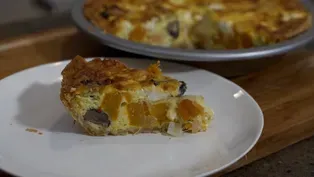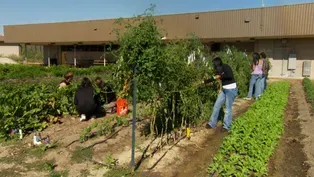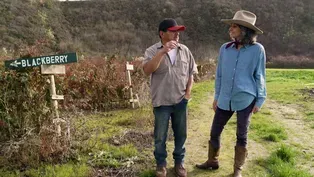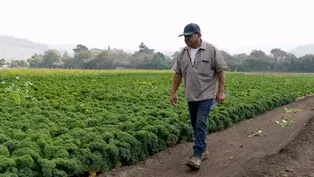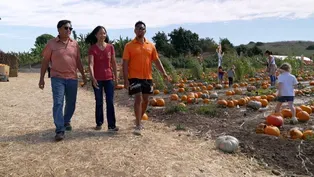
Episode 2
8/9/2024 | 26m 46sVideo has Closed Captions
Visit a bustling pumpkin patch, and meet a farm laborer who started his own farm.
Visit a pumpkin patch that attracts tens of thousands of people a year. Find out how to cook an autumn vegetable quiche with mushrooms and leeks. A former farm laborer starts his own farm selling berries and rosemary. Explore the nutritional benefits of berries with our health expert. Discover how an urban school in the middle of a food desert built its own farm to feed the neighborhood.
Problems with Closed Captions? Closed Captioning Feedback
Problems with Closed Captions? Closed Captioning Feedback
America's Heartland is presented by your local public television station.
Funding for America’s Heartland is provided by US Soy, Sustainable Agriculture Research and Education, Rural Development Partners, and a Specialty Crop Grant from the California Department of Food and Agriculture.

Episode 2
8/9/2024 | 26m 46sVideo has Closed Captions
Visit a pumpkin patch that attracts tens of thousands of people a year. Find out how to cook an autumn vegetable quiche with mushrooms and leeks. A former farm laborer starts his own farm selling berries and rosemary. Explore the nutritional benefits of berries with our health expert. Discover how an urban school in the middle of a food desert built its own farm to feed the neighborhood.
Problems with Closed Captions? Closed Captioning Feedback
How to Watch America's Heartland
America's Heartland is available to stream on pbs.org and the free PBS App, available on iPhone, Apple TV, Android TV, Android smartphones, Amazon Fire TV, Amazon Fire Tablet, Roku, Samsung Smart TV, and Vizio.
Providing Support for PBS.org
Learn Moreabout PBS online sponsorshipNarr: Coming up on America's heartland, meet the fourth generation farmers behind this pumpkin patch.
It attracts more than 120,000 people a year who come to pick pumpkins and much more.
Kenny: We get some adults that have come as children.
Now they're bringing their kids.
So that really makes us happy to see.
Narr: And it wouldn't be fall without an autumn vegetable quiche.
We'll show you how to make this savory dish featuring butternut squash, mushrooms and leeks.
Plus, discover how this former immigrant and farm laborer is realizing his dreams by the California coast where he sells berries and rosemary.
Jose: And we've been happy.
We have a good life.
Narr: We'll dive deeper into the nutritional and health benefits of those products with Dr. Daphne Miller on harvesting health.
And we'll show you how an urban school in the middle of a food desert planted its own farm that's feeding the community.
Sabina: So we knew that there was a need and a problem that we could solve for our community by building the farm.
Narr: It's all next on America's heartland.
Annc: America's heartland is made possible by.
[♪♪♪] ♪ You can see it in the eyes ♪ ♪ of every woman and man in America█s ♪ ♪ Heartland living close to the land.
♪ ♪ There's a love for the country ♪ ♪ and a pride in the brand ♪ ♪ in America's Heartland ♪ ♪ Living close... Close to the land ♪ ♪♪♪ ♪♪♪ Narr: Stand in the pumpkin patch at Tanaka Farms and nearby Interstate 405 and all the housing developments surrounding you somehow feel a world away.
Kenny: There used to be all farmland throughout Orange County here, but now there's not too many farms left.
Narr: Kenny Tanaka and his parents, Glen and Shirley farm at three locations in the heart of upscale Irvine in Southern California.
Kenny: So on this location, we have 30 acres.
We have pumpkins, squash, green beans.
Throughout the year, we'll go broccoli, carrots, radishes, a little bit of everything.
But behind us, we have about 20 acres of pumpkins that we're growing right now.
October is our biggest time of the year.
We sell a lot of pumpkins and invite people on the farm to pick their own pumpkins.
Our other big crop is strawberries.
Pretty much springtime for us.
Narr: These are not the first farmers in the Tanaka family.
Takeo worked as a farmhand when he arrived in the U.S. from Japan in the early 1900s.
The second generation Nisei in Japanese was George, who farmed until the start of World War Two when executive order 9066 put an end to a lot of California farms.
That executive order displaced 120,000 Japanese Americans who were forced to leave their homes and live in incarceration centers until the war ended.
But the Tanaka's left California before that happened.
Glenn: They said all Japanese off the West Coast.
They were fortunate, they had some friends in Utah, and so they were able to pack what they had and go to Utah.
That's where he met my mother.
My mother had already been living in Utah.
Narr: Glenn's parents married in Utah after the war.
The family returned to California, found land and started all over again.
Glenn: It was funny.
I was never told I was going to take over the farm.
It was just kind of understood.
Narr: But the business of farming had changed.
Over the years, Glenn made adjustments by adding a produce stand and gift shop and by offering community supported agriculture or CSA memberships.
And he still finds creative ways to market his crops.
Kenny: He's really good about pivoting.
During COVID, we really had to pivot and we did a drive through produce stand drive thru pumpkin patch.
Glenn: And that really touched the lives.
I still get people coming up to me now and say, You did a great thing for the community.
Narr: The farm█s successful expansion into agritourism started when Kenny was little.
Kenny: My mom brought our preschool class out to the farm.
And for the pumpkin patch, she showed us how seeds were grown and then showed us some of the vegetables when they were grown, let us pick a few and then take home a pumpkin.
Narr: Now more than 60,000 school kids visit Tanaka Farms every year on field trips.
Families visit, too, with as many as 120,000 people in a year for weekend events.
In just about any season, visitors can get their hands dirty and find out what vegetables look like before they reach the grocery store.
Kenny: I█ve seen joy when they pick vegetables out of the ground because most of them never seen something like that.
So it's a really good experience.
Narr: Tradition is important to the Tanaka family and to their visitors.
Kenny: We get some adults that have come as children.
Now they're bringing their kids.
So that really makes us happy to see.
Narr: Visitors also learn about the Japanese-American farmers who lost their land during World War Two.
Glenn: We have a wall down there called the Issei, Nisei Farmers and their legacy.
That's the first and second generation Japanese-Americans that were over here.
There's probably over 7000 farms by Japanese-Americans, and of those, there is probably 6000 on the West Coast.
And every ethnic group has their history and story.
But this is really one that we think doesn't -- can't be lost because it talks about the, you know, the illegal incarceration of American citizens.
Narr: The Tanaka's are in their fourth generation, in part because they love farming in part to honor the history of Japanese-American farmers and in part to cultivate community.
Glenn: And with that community involvement, we've... we've probably helped our own business along the line but that really wasn't the intent.
It was getting involved with the community, being a part of the community and helping them out, because that's something businesses need to do.
I can't give you a good reason why.
It's just that's what we're supposed to do.
Narr: Agritourism is growing in popularity across the U.S., whether it's a pumpkin patch, a corn maze, an apple farm, or u-pick berries.
These farms introduce families to agriculture while preserving farmland and open space.
Revenue from agritourism tripled from 2000 to 2017, according to the USDA.
That's expected to grow as more people seek out these authentic farm experiences, often with picture perfect backdrops.
[♪♪♪] Sharon: Let█s make an autumn vegetable quiche featuring butternut squash.
Whatever butternut squash shows up in the grocery stores and farmer's markets.
I know it's fall season, and it's time to get cozy.
To get started, we're going to prep our squash.
Peeling butternut squash can be a little contentious for some people, so I'm going to attempt to make it a little bit easier for you.
Going to cut where those two parts meet.
We're only going to use this side of the butternut squash today.
Now we have to get to peeling it.
So I'll remove the stems side from here.
You have two options if you have a y shaped peeler that is sharp enough, you can actually go ahead and peel the butternut squash like this.
Or another option is to get a, again, sharp knife and just peel all the way down.
For this quiche, we are roasting our vegetables.
And whenever you roast vegetables, what you get is more sweetness and a more concentrated flavor out of them.
Our squash is prepped.
So now let's move on to our other ingredients.
We have mushrooms here.
Whenever you roast a variety of vegetables together on the same baking sheet, what you want to make sure of is that they all cook at the same pace and that they're done around the same time by just quartering the mushroom.
Rather than slicing, they will finish around the same time as the butternut squash.
Finally, let's prep our leeks.
Leaks are not really tricky, but you want to be careful when you're prepping them because there's often sand trapped inside.
So let's make sure that this leek is clean before we roast it.
I go all the way up to the point that the greens start.
See between these layers, I can even see from here there is some some sand, so I'm going to slice it in half lengthwise like this.
Expose the insides.
I'll rinse these under the faucet and then come back to finish prepping it.
Our leeks are rinsed and now we'll slice them into about half inch thick slices.
If you can't find leeks, they're not in season.
You can definitely use a shallot or a yellow onion or even a red onion instead.
Finally, let's add some salt and a little bit of olive oil.
These vegetables are ready to go into an oven at 425 degrees for about 30 minutes or until the butternut squash is soft all the way through.
Now that the vegetables have roasted and cooled, we can assemble our quiche.
So first, let's make the custard.
I have four large eggs going into a bowl for a rich and almost creamy quiche.
I'm using heavy cream.
We█ll add some black pepper, some salt.
And because this is an autumn vegetable quiche and we've got butternut squash in it.
I'm also adding some thyme.
I have about four sprigs.
Give it a little bit of a chop, and then into our custard it goes.
The last ingredient to go into the bowl.
Parmesan cheese.
Putting in about a quarter cup of parmesan.
Whisk it.
Custard is ready.
So now let's assemble everything.
Here I have our quiche crust.
It's already blind baked.
It's a very simple recipe.
I used it for every type of quiche.
And here's how you make it.
Begin by adding two and a half cups of all purpose flour and one teaspoon of salt to a food processor and give it a pulse.
Now, add one and a half sticks of very cold butter and pulse it until the butter is distributed throughout the flour.
Now we need the flour to come together, starting with two tablespoons Add ice, cold water and pulse.
If you can grab some of the flour mixture, press it together between your fingers and it looks like dough.
It's ready.
Pour the dough out onto a countertop and bring it all together until it forms a mass of dough.
A bench scraper helps you get the job done.
Wrap the dough and transfer it to the fridge for at least 30 minutes before blindly taking the crust.
To our prepared quiche crust, we'll start to add these vegetables, and right on top of the vegetables, we█ll add our goat cheese.
And finally, we'll pour the custard right on top.
In order to get a nice brown crust, more parmesan cheese.
This is ready to go into the oven at 375 degrees for about 45 minutes.
Our quiche is out of the oven and we let it cool for about 20 minutes and it's still warm and ready to eat.
So let's slice into it and see what it looks like.
Nice and flaky.
Look how beautiful that is.
Let's give it a taste.
What a perfect way to welcome Autumn.
And now all that's left to do is finish this slice of quiche.
[♪♪♪] Still ahead on America's heartland, a school surrounded by fast food decides to build its own farm, growing produce for students and their families.
Jaron: They are bringing these foods into their homes, and this is like their quasi grocery store.
Narr: But first, let's journey to the California coast, where you'll find a Farmstand and U-Pick berry farm run by a husband and wife who say they are realizing the American dream.
Nutrition expert Dr. Daphne Miller also visits their farm where she unpacks Why these berries are good for your health and the soil.
[Ocean Sounds] Jose: I love it.
I love farming.
That█s my thing in my blood.
I guess.
I don't know.
I guess it might -- it█s what I like.
Narr: Talk to Jose Ramirez and you learn right away just how much he loves working the land and just how proud and grateful he is to be able to farm about 90 acres in Pescadero on California's Central Coast, just a short distance from the restless Pacific Ocean.
Jose: It's a real small town, quiet community, soil is beautiful, it█s rich, nice soil we got here in Pescadero.
Narr: Today, Jose and his team are harvesting rosemary, A hardy and fragrant herb.
Also being pictured a green kale.
The farm also grows pumpkins, peas, beans and berries, which visitors are welcome to pick while visiting the farm store run by Jose and his wife, Claudia.
Much of their other produce goes to local restaurants, suppliers or retailers.
Jose: Rosemary, we harvest every day It█s the one it sells every day.
It gives you money every day.
It's not a lot, but it helps for the other stuff.
Narr: Jose will tell you his journey to becoming a farmer is the embodiment of the American dream.
At age 15 and alone, Jose immigrated from Mexico to California to live with an uncle and older brother.
He found work with a local flower and vegetable grower and spent the next 20 years learning the business, eventually becoming farm foreman.
Jose saw it as his chance to learn all he could about agriculture.
Narr: Everybody has the opportunity.
You just don't want to take it.
It's up to you.
Narr: Over time, financial necessity compelled Jose to take a full time job at the local school district.
He still farmed a single acre, but after ten years, his enduring love of the land compelled him to try to return to it in a bigger way.
Narr: I was working too much time at the school and not enough time in my farm.
So I said, What would be better?
Quit... Quit the school or quit farming?
I have to do one of the two.
So I decide quit school and go to farming.
Narr: For Jose, that decision and that opportunity came through Peninsula Open Space Trust, a nonprofit dedicated to preserving open space across Northern California from forests to farmland.
Nearly half the farm acreage here in San Mateo County has been lost to development or private non-farm ownership.
In 2012, POST bought a 900 acre farm and is leasing part of it to Jose.
They've also helped to make improvements like new irrigation systems and even restoring this farmhouse now doubling as a produce store.
Dan Olstein, POST director of land Stewardship, says Jose is exactly the kind of farmer they seek.
Dan: He's so dedicated to what he... what he does.
He's an incredible farmer.
He's got great instincts on the land and it's been great to see that blossom, uh, under our ownership.
And, you know, the goal is for him to own that farm.
Jose: If it wasn't for them I would've never got the chance.
Dan: There's an incredible amount of interest from different folks, from different backgrounds who... who grew up farming.
Our hope is that we can find opportunities to help those folks own their own farms or their own farm businesses.
Claudia: This side is raspberry and this side in the corner, is blackberry.
Customer: Oh, down there?
Claudia: Yeah.
OK.
Thank you.
Customer: OK, thank you so much, Narr: For now, Jose says he's satisfied working each day, harvesting the bounty from this rich soil.
Building a legacy for the next generation and perhaps providing hope to others who share his dream of coming from modest means to join the ranks of America's farmers providing healthy food to the nation and the world.
Jose: I think I got more of what I deserved because my main thing was my family and I still say my family.
I'm not saying that we... we█re rich, but we're not poor and we've been happy.
We have a good life, really good life.
We got.
[♪♪♪] Daphne: So here we are at R&R Herbs with farmer and owner Jose Ramirez.
Jose, tell me, how many kinds of plants are you growing here?
Jose: It's blackberries, strawberries, raspberries and olallieberries and rosemary.
Daphne: That sounds like a lot of perennial plants.
Why do you like those plants?
Because you don't have to plant it every year.
Daphne: So you plant your Blackberries, and then how many years does it take before they really are producing at scale for you?
Jose: Blackberries produce the same year.
olallieberries take two years.
Daphne: And how about rosemary?
Jose: Rosemary.
It takes probably a couple of years or more before you have a good, you know, full production.
And we have plant has been in the ground for 50 years.
Daphne: Wow.
Jose: Yes.
And it█s still producing.
Daphne: And that whole time, it's got its roots in the soil and it's protecting the soil.
Jose: Oh yeah.
Oh yeah.
Daphne: It turns out that growing perennial crops is great for the soil.
These roots also help the plant access, water and minerals deep in the soil.
So that that plant requires less fertilizer and less water.
Because these plants are not uprooted, there is less tilling a farm practice which can harm soil microbes.
Perennial crops block out weeds, so there's less of a need for herbicides.
Perennial crops are also great homes for birds, butterflies and other pollinators, which help all the plants on the farm do better and lower the need for herbicides.
The fruit that grows on perennial plants.
Because these plants tend to be hardier.
The fruit is so good for you.
So strawberries, olallieberries, raspberries, blackberries are incredibly rich in phytonutrients.
Those chemical compounds that help our bodies fight cancer and even decrease our risk of diabetes and heart disease.
While the roots are promoting healthy bugs in the soil, the berries are doing the same in our gut by promoting a healthy microbiome.
One cup of berries offers about one third of our daily fiber needs.
I like to have mine on a salad or with a scoop of plain Greek yogurt and some chopped almonds or walnuts as garnish.
Rosemary is great with roast chicken and squash and potatoes and rosemary.
Essential oil rubbed on painful joints will help alleviate pain and inflammation.
Having a little bit of rosemary extract can help with your digestion.
It can also calm you or soothe your nerves just to smell rosemary.
So it's also used as an aroma therapy.
So it has a lot of more medicinal purposes as well.
Given all the ways that perennial crops impact soil health and our health.
We want to see more of them.
Perennials cover most of the earth, but make up only 13% of our cropland.
Fruit and nut trees and berry bushes are among the most common types of perennial crops.
But what about perennial vegetables?
Some in this region include asparagus and artichokes.
And in the Midwest, farmers are beginning to experiment with perennial wheat called Kernza, which is a cross between a wild wheat grass and your typical annual wheat.
It has twice as much protein and fiber as your standard wheat and a lot more disease fighting phytonutrients.
Perennial plants that have permanent roots in the ground are a win-win win for the farmer and the soil and eaters like us.
[♪♪♪] Narr: When the COVID pandemic shut down California public schools in 2020, many campuses within the Anaheim Union High School District became Food distribution centers.
Sabina Giokoumis is a teacher at Magnolia High School, took notice.
Sabina: We saw how many people needed produce, so we knew that there was a need um, that -- and a problem that we could solve for our community by building the farm.
Narr: The farm is the Magnolia Agriscience Community Center, or MAC for short.
Building it was Anaheim's response to California's ambitious $3 billion initiative to dramatically expand its number of community schools.
Public schools that not only educate students but also provide support and services to the neighborhood as a whole.
Jaron: What we're standing on used to be an empty dirt lot.
Students have identified food deserts as a very real issue that is facing our community where there's fast food restaurants, all around us, but there's not a lot of grocery stores or places for families to go to get organic, healthy foods.
So and this is contributing to obesity and health issues that we're seeing in our community.
Mimi: The only foods that are really there for the community are junk food and things that do not benefit or give us any nutritional value.
And us as students, found community gardens as a very good and efficient solution.
I'm seeing the vegetables and fruits being grown in our MAC, the Magnolia Agroscience Community Center being taken into our cafeteria.
I've also seen it helping families and parents and students by providing them with locally sourced, healthy, nutritious food.
Monty: So every month we have this thing called the community dinner, so anyone in the community can come to our school they could... they could buy our produce, they could taste our produce.
Jaron: We have boxes that we sell to local communities, to local families that are... that are taking these boxes and they are bringing... bring these foods into their homes.
So this is like quasi grocery store.
Intern: For every pound of textiles produced in Indonesia - Narr: The farm feeds the community, but it also helps educate the students.
Their instructors are interns from the University of California, Irvine, Sabina: They teach lessons around pollination, around sustainable agriculture, around pesticides and runoff.
Growing Food in a changing climate.
Using UCI science students as our teachers so gives them a little teaching experience.
It gives us smaller class group sizes to learn about urban farming and sustainable agriculture Jaron: And then the learning that is happening here with our students, they're able to go back and speak to their families, speak to their four friends.
And we're seeing a ripple effect in terms of making healthy... healthier choices.
Narr: Sabina Giokoumis believes California's initiative to increase the number of community schools is vital.
Sabina: In a time right now in America, where so many of our schools are building up walls around our schools for safety, that does feel a little bit like we as the community are being pushed away or what happens inside of schools is secret.
And so it is important that we... that we reach out to our communities and let them know we're here.
We have resources, come in, tell us what your community issues are so that we can become an asset and problem solve alongside with you.
Annc: That's it for this edition of America's Heartland.
For more stories, full episodes and recipes, visit AmericasHeartland.Org , or connect with us on Facebook.
♪ You can see it in the eyes ♪ ♪ of every woman and man in America█s ♪ ♪ Heartland living close to the land.
♪ ♪ There's a love for the country ♪ ♪ and a pride in the brand ♪ ♪ in America's Heartland ♪ ♪ Living close... Close to the land ♪ Annc: America's heartland is made possible by: ♪♪
Autumn Vegetable Quiche – Farm to Fork with Sharon Profis
Video has Closed Captions
Clip: 8/9/2024 | 5m 41s | Find out how to cook an autumn vegetable quiche with mushrooms and leeks. (5m 41s)
Connecting and Feeding the Community
Video has Closed Captions
Clip: 8/9/2024 | 3m 20s | Discover how an urban school in the middle of a food desert built its own farm. (3m 20s)
Growing Perennials – Harvesting Health
Video has Closed Captions
Clip: 8/9/2024 | 4m 6s | Explore the nutritional benefits of berries with our health expert. (4m 6s)
Video has Closed Captions
Clip: 8/9/2024 | 4m 18s | A former farm laborer starts his own farm selling berries and rosemary. (4m 18s)
Video has Closed Captions
Clip: 8/9/2024 | 5m 50s | Visit a pumpkin patch that attracts tens of thousands of people a year. (5m 50s)
Providing Support for PBS.org
Learn Moreabout PBS online sponsorshipSupport for PBS provided by:
America's Heartland is presented by your local public television station.
Funding for America’s Heartland is provided by US Soy, Sustainable Agriculture Research and Education, Rural Development Partners, and a Specialty Crop Grant from the California Department of Food and Agriculture.
